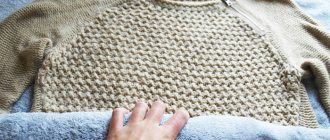If your T-shirt is small or has shrunk after washing, there are several ways to increase the width, length, or size of the item. The choice of method depends on the type of fabric. Before stretching a shrunken item, washing or ironing clothing, be sure to read the label and follow the recommendations, otherwise you risk damaging and deforming the material.
In this article we will look at how to stretch a T-shirt a size larger at home. And we’ll find out what to do if clothes are small or shrink after washing.
How to stretch a stretch dress wide. How to stretch clothes that have shrunk after washing
We often face the problem of things shrinking after washing. Such clothes immediately lose their aesthetic appearance and cannot be worn. However, the thing can still be saved by stretching it. You can perform the procedure in several ways.
Why do things shrink after washing?
Most often, knitted items are more susceptible to shrinkage due to the shrinking properties of the threads. However, there are frequent cases of shrinkage of things made from other materials that, it would seem, cannot shrink.
Such phenomena can be caused by several factors:
- clothes are made from low-quality material;
- heavy contaminants were not pre-treated;
- the label on the product was not read;
- the washing mode was selected incorrectly;
- spin speed too high;
- the rules of drying and ironing were violated.
In this case, the fundamental reasons for shrinkage are incorrectly selected products for certain materials or unsuitable washing temperatures.
Wrong detergent selected
Some materials do not react well to regular powder. This is explained by the fact that the alkali contained in classic laundry detergents negatively affects the quality of the threads, as a result of which they lose their original shape.
Similar consequences can occur if you have not first studied the label on the product or are not familiar with the composition of the powder.
Incorrect washing temperature
Most delicate fabrics do not tolerate high temperatures or changes in temperature. For example, if you wash clothes in hot water and then rinse them in cold water, the item may shrink after washing.
Always read the information on the permitted processing temperature on the label and set your machine to the appropriate delicate wash program.
How to stretch a shrunken item
If your favorite wardrobe item shrinks after washing, it can still be saved. You can stretch clothes in several ways using available materials.
Water
The first and most accessible method you can use is stretching with water. For this:
- Soak the item in cool water for 10-15 minutes, allowing the liquid to completely absorb into the threads.
- Remove and, without twisting, squeeze with a towel.
- Lay out a large towel on a horizontal surface and place the item on top.
- During the drying period, stretch the material from time to time and replace the towel with new ones.
Do not use heat sources for drying during the procedure, otherwise all the work will be done in vain.
Iron
This procedure is not suitable for knitted items made from natural or synthetic threads.
Operating procedure:
- Wet the item with cold water.
- Let the water drain and place it on the ironing board.
- Pull the material in the desired directions.
- Set the iron to low or medium heat.
- Iron the material with maximum effort while simultaneously stretching the fabric.
- Turn the product inside out and repeat the procedure.
After ironing, lay the clothing on a towel or sheet, pull the fabric again and press down the edges with a weight. Leave the item to air dry.
Hydrogen peroxide
Hydrogen peroxide is not only an excellent antiseptic. The substance will help return shrunken clothes to their previous shape.
Mode of application:
- Dissolve 50 ml of peroxide in 8-10 liters of cold water.
- Soak the product for half an hour.
- Carefully remove the item and wring it out with a towel.
During the drying process, come up and stretch the item from time to time, giving it the correct shape.
Using a sewing machine
It's easy to alter jeans. The first method is to reduce the allowance. You need to open the side seams and stitch them again as close to the cuts as possible. The advantage of this method is that it is easy to perform at home. The disadvantage is that the color of the allowances will differ; as a rule, the material there is darker.
The second method is to sew on stripes. Instructions:
- Choose the material for the inserts to suit your taste.
- Cut the pants along the side seam or open them.
- Sew by inserting stripes.
Another option is to widen the belt. Instructions:
- Open the back or side seams.
- Insert one or two triangular wedges of fabric. You can use knitted or elastic tape.
- Stitch.
Embroidering jeans is an effective option for resizing. Flaws:
- Difficulty of execution. Sewing skill required.
- You will need a sewing machine, additional tools, and materials for inserts.
- There is a risk of ruining your jeans.
https://www.youtube.com/watch?v=JAsBkgeLW7U
Expander-spacer for increasing the belt. How to use:
- Soak buttoned stretch pants in hot water.
- Insert the extender.
- Using the lever, gradually expand the device.
- Secure it to the maximum.
- Let dry.
The expander works well to stretch out skinny jeans. Flaws:
- after each wash, the procedure must be repeated;
- there is a risk of tearing the item;
- Not suitable for increasing length, fullness in the legs.
In situations where there is no result using the listed methods, it is worth moving on to drastic measures using sewing skills. This will help make skinny jeans look bigger and further decorate the pants.
- steamer or sharp razor;
- scissors;
- a needle and thread, preferably specifically for denim material;
- a piece of soap;
- ruler;
- pins.
Pants that are turned inside out are ripped at the side seams. If the jeans are small in the hips, the seam opens up to knee level. The folded fabric is unrolled and the new stitch location is pinned. The line of stitches is carefully drawn, after which the trousers are sewn again.
An effective way to increase a product by 2 sizes is to use a fabric insert on the sides of the pants. If you choose the right fabric for stripes, the product will sparkle with new colors and will delight you for a long time. Before the process, you should familiarize yourself with existing jeans models that use a similar decoration method to better understand the combination of different textures and color shades of fabrics. A cut for work will be required with a width of no more than 50 cm.
- The jeans are ripped at the side seams; it is better if the existing seam is completely removed. The work requires accuracy!
- The pants are put on and a piece of fabric attached to the inside is secured with pins.
rastyanut-dzinsi-19
rastyanut-dzinsi-20
rastyanut-dzinsi-21
rastyanut-dzinsi-22
rastyanut-dzinsi-23
rastyanut-dzinsi-24
- The jeans are removed and sewn together with running stitch.
- To be on the safe side, another fitting is recommended.
- Having folded the edges of the denim fabric, the design is sewn together on a sewing machine (the edges do not need to be folded if the design decision requires it, for example, the presence of fringe made from denim fibers).
In addition to regular fabric, fashionistas use a strip of lace, or sew the edges with colored thick threads with an indent. It all depends on imagination and skills. When you only need to enlarge the waist area, you can rip out the waistband and side seam, and sew thick fabric or elastic in the shape of a triangle. Such an insert will not be noticeable under a jacket.
Add length
You can also stretch your pants to length without resorting to stretching. It is enough to loosen the seam allowances along the bottom of the trouser leg, either using the stripe method with the addition of fringe or a piece of other fabric.
How to stretch lace.
How to stretch lace
How to stretch lace
Vologda, Irish, Bruges... lace is invariably captivating. When choosing lace and guipure dresses, women know very well how charming and elegant they look, decorated with their elegant patterns!
Sewing clothes from lace fabric with your own hands is not at all difficult if you know a few simple rules.
First, you need to decide what occasion the lace outfit is for. For example, lace over a satin base is a great choice for a wedding or evening dress.
However, even on weekdays, guipure blouses and skirts, as well as lace appliques, melodiously called “merezhivo” in Ukraine, will beautifully and organically complement the clothes of a business woman or denim items for a walk in the park.
Why do things shrink
Often such a surprise comes from new things. Exposure to water and violation of washing rules cause a shrinkage effect, especially during the first wet treatment.
The reduction in the size of things is due to the structure of the fiber. Thus, cotton in its natural position has the appearance of a twisted spring. When making threads, the fibers are treated with chemicals to straighten and stretch the fiber. And she is able to maintain this state until the first opportunity. When the right conditions arise, the fiber can curl again. Most often this happens when the recommended rules of care are violated. In other words, when extreme conditions arise, the protective properties of chemical treatment are leveled and the fiber tends to its natural state.
The wool shrinks differently. The down of animals, which we call wool, has a scaly structure on the surface. These horny structures, like fish scales, cover the entire surface of the pile. If the hair begins to wrinkle and bend, the scales begin to bristle and cling to each other. This is similar to the rolling process. The size decreases due to the fact that the threads fluff up and then become fixed in a compressed state.
And if you pour boiling water on wool, the structural protein of the hair, keratin, undergoes denaturation (irreversible reduction), as a result of which the item shrinks very strongly and irrevocably.
Flax fiber has a spindle-shaped shape. It is smooth and strong, but can also shrink, especially when treated with hot water. The shrinkage of flax is not critical, and when ironed, the fiber returns to its original size.
The fabrics that manufacturers use to sew T-shirts have different compositions. They can be natural, mixed and synthetic.
Materials made from mixed fibers and synthetics are least susceptible to shrinkage. The following table shows the maximum shrinkage percentage of different types of fabrics.
| Fabric type | Shrinkage along length (%) | Shrinkage width (%) |
| Cotton | 3 | 2 |
| Viscose | 4 | 2 |
| Silk | 5 | 2 |
| Wool | 3,5 | 3,5 |
| Capron | 1,5 | 1,5 |
| Elastane | 10 | 10 |
Now, by imagining what knitwear fibers look like and why they change length, we can determine the appropriate washing conditions for such products and understand how we can return things to their original appearance.
How to stretch knitted pants. How to stretch your pants
After washing, you may encounter the problem of things shrinking. Often, when washing, various pants - men's trousers, sports pants, jeans - became a size, or even two smaller. Is it possible to somehow improve the situation?
Instructions
1
The very first thing to consider when washing is the composition of the fabric from which your pants are made. Be sure to read the label before putting them in the washing machine. After all, different fabric compositions require different temperature conditions.
2
When washing men's trousers that contain more than 50% wool, be very careful. The water should be no more than 40 degrees and it is preferable to use a delicate wash cycle. If the pants do shrink, you can stretch them this way: turn them inside out and lay them on an ironing board. Dampen a linen napkin, lay it on top and iron the trousers through it, at the same time slightly stretching them. Continue until completely dry. Just keep in mind that you can stretch the trousers by a maximum of half a size in this way.
3
Sweatpants containing natural thread can be stretched immediately after washing. Take the still damp trousers and evenly stretch them in length or width, depending on where they have shrunk. After this, carefully place it on a dry towel and let it dry. After drying, if the product has not stretched enough, sprinkle with water and stretch and dry again. Usually there are no problems with such pants - they stretch quite easily.
4
If you need to stretch your jeans, then this procedure is quite troublesome. Try on your still wet pants and decide where they become narrower. If only in the belt, then pull it out. This will require significant effort; you can ask your husband to help you. Do the same with the length. If the pants have become shorter, take two people: one by the waistband, the other by the bottom and pull.
5
If you need to stretch your jeans wider, use a proven method. Put on warm tights or sports tights, and try to pull on still wet trousers on top. It will take you some time and you will have to put in some effort. It may be easier to perform the process while lying down. After this, try to walk around the apartment for about ten minutes in this attire. Then take off and hang your pants to dry, only away from the radiator.
6
In the future, try to wash your pants at lower temperatures, in accordance with the fabric care requirements.
Do jeans stretch?
High-quality jeans can be stretched by 1-2 sizes.
Jeans are sewn from denim . This is a durable fabric, but has little elasticity. To make the material elastic, various synthetic threads are added to it. This material stretches, and after it has been washed, it narrows, so you can stretch it by about 1-2 sizes.
You can stretch your jeans in the following ways:
- Soak in water, twist and then stretch by hand
- Stretch wet jeans with a special expander
- Spray with water and iron with a hot iron
Jeans stretch well in width, but in length they stretch less.
How to stretch a cotton dress to length. How to stretch a wool dress
Wool is a capricious material that can easily shrink and become deformed due to hot water and temperature, high humidity and even prolonged storage folded. If a knitted or woolen dress shrinks, pour cool water into a basin and place the clothes there. Then remove the product and carefully wrap it in a large terry towel or sheet. Do not wring out woolen items under any circumstances!
Leave the wrapped dress for 15-20 minutes. And when the moisture is absorbed, hang the product on a hanger, straighten the fabric and leave until completely dry at room temperature, preferably in a room with good ventilation. Alternatively, you can soak a wool dress in cold or cool water using a spray bottle and put it on yourself, and then wear it until it dries.
Another way to stretch a woolen or knitted dress is a solution with ammonia, turpentine and vodka. Take three tablespoons of each component and add to five liters of water. Stir and dip the shrunken dress into the mixture.
Leave for ten minutes and then dry upright at room temperature. After this treatment, the wool becomes elastic and stretches well. You can give the material the desired shape.
You can also make a solution with baking soda. Add three to four tablespoons of soda to two liters of water, mix and immerse the affected item there. Leave for 4-6 hours and then wash as usual. Then rinse the product in a solution of two liters of water and ten tablespoons of tartaric acid or wine vinegar. Leave the product in the solution for two hours, then rinse in clean water and send to dry.
If you want to stretch a wool dress to length, hang the wet item on a mannequin or hanger, attach a small weight underneath and leave to dry completely. The fur will quickly stretch downwards. You can extend the sleeves in the same way. Wool must be washed and ironed, dried and stored very carefully and in compliance with certain requirements.
To prevent woolen items from shrinking or stretching, do not store them folded for a long time, but take them out and air the material at least once or twice a month. Wash material containing more than 50% wool only on a delicate cycle and at a cool temperature of up to 30 degrees using special detergents for wool fabric.
Dry clothes flat unless you want them to stretch out. Read more about how to care for woolen items here.
Vinegar or boric acid
This soaking is suitable for woolen and cashmere sweaters and dresses.
If the item shrinks after washing, this method is ideal for restoring it to its original size, but be careful with it.
Synthetic shirts should not be soaked in boric acid or vinegar.
Because of this, the fabric may deteriorate and your favorite item will have to be discarded or completely thrown away.
How to stretch:
- Seal your bathroom sink with a stopper or use a basin. Fill a container with 1 liter of water. Liquid temperature - up to 40 degrees. You can pour cold water, this is even better, especially for wool.
- Then add one of the following products to the water per 1 liter of water: boric acid - 1-2 tbsp. l., white wine vinegar 500 ml. White wine vinegar is preferable to distilled vinegar, but if you don't have either at home, you can use regular table vinegar.
- Place the product in a container with the prepared solution. Soak clothes for about 25 minutes. What to do if the item shrinks a lot? After 25 minutes, take the product out, stretch it a little in length and width, and soak again. Leave the product to soak in the solution for another 25 minutes.
- Remove clothing from the solution and remove excess moisture. There is no need to rinse the item. The solution should continue to actively weaken the fibers.
- Button up your shirt or jacket, take dry, non-fading towels and stuff the jacket with them until it reaches the desired size. If there is a mannequin or a suitable object, then pull the T-shirt over them. The structure should be even, it is better to roll the towels into rolls and then stuff them, so the item will stretch evenly.
- After 30 minutes, remove the towels (remove the item from the mannequin) and put them on hangers. Leave the jacket to dry.
Repeat this procedure endlessly until the product reaches the desired size.
How to stretch a stretch dress to length. HOW TO EXTEND CLOTHES
1. This is probably one of the most common methods. He looks just great! Add a strip of fabric or lace along the bottom of the product. Color and material depend on your imagination.
2. This season's fashion trend is an insert made of transparent fabric. Place it on the hem of a skirt or light summer dress.
3. And this is an even more radical transformation of trousers. Openwork inserts are placed not at the bottom, but in the middle of the product. To enhance the effect, you can decorate your pockets and belt with lace. Personally, I really like this option.
For girls who love a sporty style of clothing, knitted cuffs will be an excellent option for changing the shape of trousers.
4. If we talk about blouses and jumpers, then there are a huge number of options. The most popular of them is adding lace inserts along the bottom of the product.
5. After looking at this photo, I immediately wanted the same summer T-shirt. To remake it, you need to make a contrasting fabric insert in the middle of the product.
As you can see, you don’t always need to throw away a tight blouse or a too short skirt, especially if it concerns your favorite clothes. Use these simple but resourceful tricks and stay on trend!
Many people have experienced that their dress has shrunk in size after washing. This can happen especially often with natural fabrics. The more natural threads in the material, the higher the risk of clothing shrinkage.
Don't despair, as you can try to return things to their previous appearance. But how to stretch a dress correctly so that it doesn’t get damaged? To do this, you must strictly adhere to some rules.
What rules should you follow to prevent clothes from shrinking?
Rice. 5. Decoding the signs on the label
The most important thing in preventing clothes from shrinking is to wash them correctly. Exposure to the fabric structure of high temperatures, deformation during spinning, chemical reactions from powder and bleach - all this can lead to a change in the shape of clothing. To ensure that washing occurs without undesirable consequences, you must follow the following simple rules:
- wash things only when necessary, do not do it too often;
- sort items by type of material (do not wash coarse and synthetic fabrics with thin and natural ones);
- be sure to use the recommendations for choosing the washing temperature (the label on the clothing indicates the maximum allowed);
- Wash heavily soiled items separately from lightly soiled items.
It is not difficult to follow the rules, and the service life of things will increase significantly.











